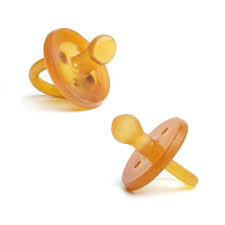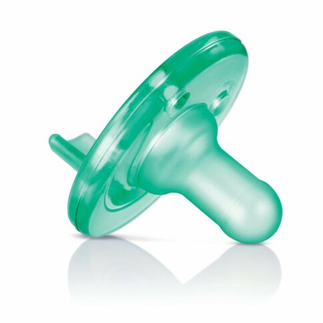To Pacify or Not?
- Lindsay
- Feb 26, 2023
- 4 min read
Struggling to know what pacifier to choose? Or even wondering if a pacifier is “good” for your baby?

Every item on a baby registry seems to have a zillion options and there are so many decisions to make!
Let’s break down pacifiers from a Pediatric Occupational Therapist's perspective - the pros and cons, what to consider, and best ones to choose.
Disclaimer, this is not medical advice. I am by no means a pacifier expert nor do I have advanced knowledge of oral motor development, but there are a few things to consider.
Pacifiers are not a right of passage for babies. They don’t NEED to have one or take one.
Let’s take a moment and go back to its origins. Why was the pacifier created?
Well, like most equipment created for babies, it was designed to separate the baby from their mother (and their mother’s breast). It gives the baby something else to suck on instead of the breast. Does this make it bad…no, but why are you thinking your baby needs it?
This is where I like most people to start:
Why are you using a pacifier?
Because isn't that just what you do with babies?
Because it’s cute and it’s what you do when they cry?
Here is your friendly reminder that all crying is communication and there are many ways to soothe a crying baby. Crying isn’t bad and it’s our job to put on the detective hat to see why they’re crying. So if your baby cries and you pop in the pacifier, you might miss an opportunity to learn what they’re communicating to you.
Why else might you use the pacifier?
To hold them over before you can do a feed?
To remove your discomfort of a crying baby in public?
As a soothing tool for daycare or babysitter to use?
Or a tool to put them to sleep?
Am I using this to quiet my baby or regulate them? What’s the difference?
I think the biggest difference is examining if you are using the pacifier each time your baby cries without much thought and/or doing this frequently or most times they cry. When they cry, are you making connection (versus just popping the paci in)? Validating what they might be feeling? Examining what other reasons they might be crying (babies always cry for a reason)?
Pros
Sucking is soothing
Can be a tool to organize or regulate the baby
Can be used for teaching or training a suck, especially those babies having challenging with breastfeeding or with ties or oral tie revision work
Cons
There are a lot to choose from
Some styles or shapes can negatively impact oral motor development
Can be challenging to wean baby or toddler from
Can be used to quiet baby’s communication (therefore ignoring or pacifying their attempts to express a need)
Not great to allow them to sleep with it all night from a airway and oral motor development standpoint

General guidelines:
If your baby doesn’t take to one, do not feel like you must keep trying for “the one.” There are lots of other ways to soothe your baby and you won’t have to worry about weaning down the road. Remember, crying is communication.
Most recommendations are to wait until the baby is 3-4 weeks old to reduce chances of nipple confusion.
Ideally pacifier use stops 6-8 months. There are exceptions to this.
Remove the pacifier and close their mouth (push up the soft spot under their chin) once sleeping to support airway and orofacial development. We want closed mouth breathing, tongue to palate.
A few things when finding pacifiers:
Safe materials - not plastic - natural rubber, silicone, latex
Look for ones that mimic the tongue shape/allow tongue cupping (instead of nailing tongue to the floor)
Take blankets, lovies or stuffed animals off of the pacifier - this weighs it down and creates unwanted stress on their oral motor development
Shapes I do NOT recommend:
Bulb shaper
Ones with a flat spot
These impact the palate and nail baby’s tongue to the floor of their mouth
Better choices
Thinner, longer for tongue to cup around like the Advent Soothie and
The Ninni Co is a thinner, stretchy, malleable material and slightly similar to the breast
Below is an excellent example of using a pacifier to organize your baby:
As you probably know, you want to bring your baby to breast or bottle once they are calm. If your baby is extremely upset or having difficulty being soothed, the pacifier could be attempted. They suck, calm, and their whole body organizes. This gives you time to settle into your breastfeeding position. Now that you’re both calm, you can remove the pacifier, and replace it with your nipple and feed.
There is nothing bad about the right style of pacifier. If it’s working for you and your family, keep on going.
Personal experience share:
I did have an Advent Soothie on hand which we tried when my son started being watched by others. He was not interested and did have difficulty motor planning. I was relieved (yes, no weaning!) and bummed (how would others soothe him?!). But guess what?! The people that cared for my son, who didn’t have my milky breasts, found different ways to soothe him quite quickly.
For our next baby, I’ll probably have a Ninni on hand in case it is a tool we intuitively feel could be useful.
Biggest take-aways:
Ask yourself, “What is my baby trying to tell me?” “Why am I using this pacifier?”
If you feel like you want one, pick the appropriate shape to support oral motor development
Remove upon sleeping and close their mouth
Wean around 6-8 months
Was this helpful?
If you want to talk through any of this or troubleshoot, feel free to sign up for a Development Consult. This is a time for you to ask questions, express concerns, gain ideas for your child, or troubleshoot. And all done at your convenience - no scheduling required!
#pacifier #baby #dummy #nuke #firstyear #motherhood #babysoother #oralmotordevelopment #newbaby #newdad #newmom #postpartum #babydevelopment #mama #parenting












Comments